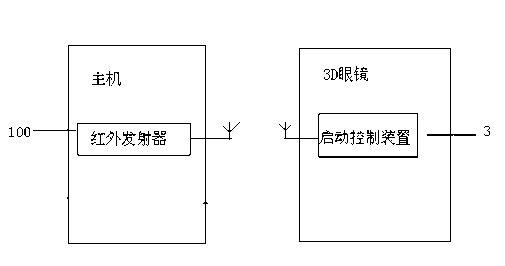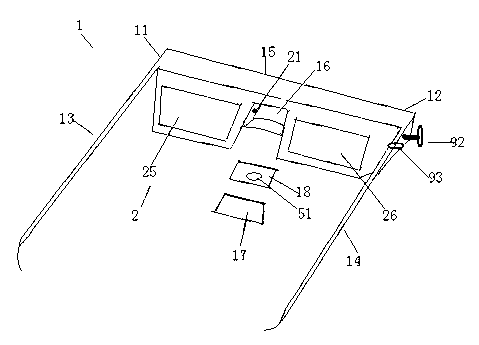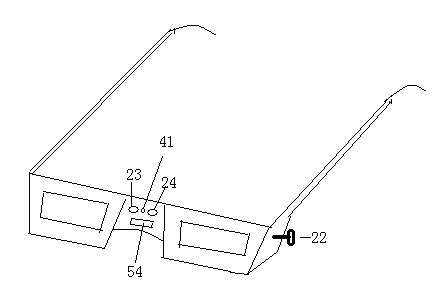Control method of 3D (Three-Dimensional) glasses system
A technology of 3D glasses and a control method, applied in stereoscopic systems, optics, instruments, etc., can solve problems such as strong sense of oppression, complex structure, and non-consideration, and achieve good effects and direct adjustment methods
- Summary
- Abstract
- Description
- Claims
- Application Information
AI Technical Summary
Problems solved by technology
Method used
Image
Examples
Embodiment 1
[0042] Such as Figure 1-4 As shown, Embodiment 1 of the present invention provides a 3D glasses system. The 3D glasses system includes a host and 3D glasses, the host includes an infrared emitter 100 for transmitting synchronous video signals through infrared rays, the 3D glasses include a spectacle frame 1, a liquid crystal spectacle lens 2 and a start control device 3, the The spectacle frame 1 comprises a left spectacle frame 11, a right spectacle frame 12, a left spectacle leg 13, a right spectacle leg 14, and a middle nose pad 15 connecting the left spectacle frame 11 and the right spectacle frame 12, and the middle nose pad 15 is The hollow structure includes an accommodating cavity 16 formed by indenting the inner side surface of the middle nose pad 15 and a cover 17 covering the accommodating cavity 16 .
[0043] The start control device 3 includes a signal receiving module 4, a power management module 5 and a central control module 6, and the liquid crystal spectacl...
Embodiment 2
[0058] Embodiment 2 of the present invention provides a control method using the 3D glasses system in Embodiment 1.
[0059] After adopting the 3D glasses system in Embodiment 1, the following control method can be used to operate the 3D glasses system.
[0060] Step S100, using the infrared emitter in the host to transmit the synchronous video signal through infrared rays; it may specifically include: the host includes a photocoupler, a microprocessor and an infrared emitter, and the photocoupler outputs the input stereo playback device The synchronous signal is converted into a corresponding voltage signal, which is input to the detection terminal of the microprocessor; the microprocessor is encoded and modulated into a synchronous video signal according to a certain format according to the voltage signal input by the photocoupler, and then output to the infrared transmitter ; The infrared transmitter emits the synchronous video signal through infrared rays;
[0061] Step S...
Embodiment 3
[0070] Such as Figure 8 As shown, Embodiment 3 of the present invention provides another 3D glasses system. The difference from Embodiment 1 is that the structure of the video control modules is different, and they can be used interchangeably. The video control module 7 in the third embodiment includes a video processing module 71, a video adjustment module 72 and a video driving module 73, wherein the video processing module 71 is used to process the first video synchronization signal including amplification and filtering obtain the second video synchronous signal, the video adjustment module 72 is used to adjust the magnitude of the second video synchronous signal to obtain a third video synchronous signal, and the video driver module 73 is used to obtain the third video synchronous signal according to the third video The synchronous signal generates a video synchronous driving signal, and the liquid crystal spectacle lens 2 is controlled to open and close alternately by t...
PUM
 Login to View More
Login to View More Abstract
Description
Claims
Application Information
 Login to View More
Login to View More - R&D
- Intellectual Property
- Life Sciences
- Materials
- Tech Scout
- Unparalleled Data Quality
- Higher Quality Content
- 60% Fewer Hallucinations
Browse by: Latest US Patents, China's latest patents, Technical Efficacy Thesaurus, Application Domain, Technology Topic, Popular Technical Reports.
© 2025 PatSnap. All rights reserved.Legal|Privacy policy|Modern Slavery Act Transparency Statement|Sitemap|About US| Contact US: help@patsnap.com



